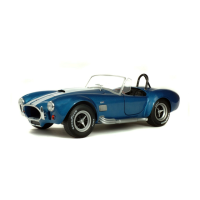Wipe away any dirt or moisture from the top of the battery and
make
sure that the connections and fixing bolts are clean and tight.
Examine the terminals and, if necessary, scrape them clean and coat
them with petroleum jelly. The taper fitting cable connector must never
be hammered on to the terminal post nor should the self-tapping screw be
used in an ttempt to tighten the connector-if necessary, a light tap with
the wooden handle of a screwdriver will do this, before the screw is fitted.
The sole purpose of the screw is to maintain a tight joint after the connector
has been fitted.
(
AMMETER READINGS
When noting ammeter readings, it must be remembered that during
daytime running when the battery is in good condition, the dynamo gives
only a trickle charge so that the charge reading will seldom be more than
a few amperes.
A discharge reading may be given immediately after switching on the
headlarnps. This usually happens after a long time when the voltage of the
battery is high. After a short time, the battery voltage will fall, and the
regulator will respond, causing the dynamo output to balance the load.
When starting from cold, the charging current will rise until it reaches
a steady maximum at a speed of say 20 m.p.h., after which it will rema in
fairly high f-or about 10 minutes and then fall to a steady charge which is
most suitable for the particular state of charge of the battery.
It will be noticed from the ammeter readings that the dynamo does
not charge at very low engine speeds. This is because it is not rotating
fast enough to generate sufficient energy to charge the battery. The
cut-out, which is an automatic switch connected between the dynamo and
battery, allows the flow of current from the dynamo to the battery only.
It closes when the dynamo is running fast enough to charge the battery and
opens when the speed is low or the engine is stationary, thus preventing
current flowing from the battery through the dynamo windings.
The regulator causes the dynamo to give an output which varies
according to the load on the battery and its state of charge. When the
battery is discharged, the dynamo gives a high output so that the battery
receives a quick recharge which brings it back to its normal state in the (
minimum possible time.
On the other hand, if the battery is fully charged, the dynamo is
arranged to give only a trickle charge which is sufficient to keep it in good
condition without any possibility of causing damage to the battery by
overcharging.
The regulator also causes the dynamo to give a controlled boosting
charge at the beginning of a run which quickly restores to the battery the
energy taken from it when starting. After about 30 minutes' funning,
the output of the dynamo falls to a steady rate, best suited to the particular
state of charge of the battery.
42

